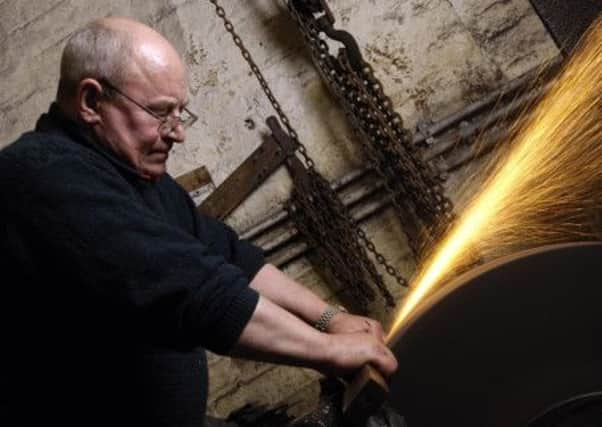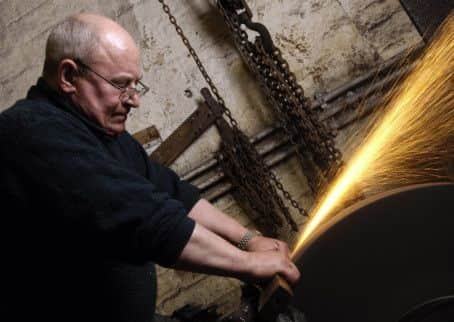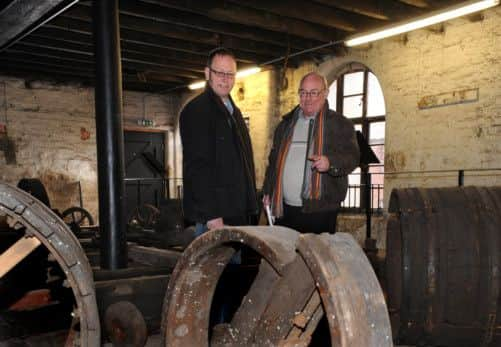Video: How Sheffield’s last grinder forged art from steel


For some people, it’s not enough just to buy Brian Alcock’s work. They want to buy his workshop as well.
“There was a museum in Germany in the late Eighties that wanted to buy everything in here and take it over there,” he says, pausing from grinding knife blades (he’s probably, though he plays it down, the world’s last jobbing grinder).
Advertisement
Hide AdAdvertisement
Hide Ad“And there was a guy from Sweden. When he saw all this, he went into raptures. He wanted to take it all. And me with it.”


Brian didn’t go, so the grimy, cluttered workshop stayed where it was, under a brick archway and across a cobbled yard in Sheffield city centre. And it has found a new role as Brian, 70, has collaborated with the sculptor Anthony Bennett on Swarfhorse, a startlingly original project. It celebrates Sheffield’s metalworking skills – specifically its grinding industry, which dates to before the 14th-century, when the miller in Chaucer’s Canterbury Tales carried a knife made in the city.
Anthony Bennett, based in Sheffield, has created a dozen art works, which are on show until next Saturday at eight different venues across the city. They include a striking sculpted head of Brian, and use – this is probably a first – “swarf” as a raw material.
Swarf is the tiny particles of metal and stone thrown off when steel is being ground on a grindstone. It splatters the “squatting board” in front of the grindstone, encrusting it with a greasy amalgam, like bark.
Advertisement
Hide AdAdvertisement
Hide AdThe Swarfhorse project, one artist-craftsman’s tribute to another, began when Bennett was studying the vast archive of tools built up by the Sheffield collector Ken Hawley (on show in the specially created Hawley Gallery at the city’s Kelham Island Museum).


“Ken showed me a hammer with a handle that a workman’s hand had moulded,” says Anthony. Worn away by constant use into an elegantly sculptured object in its own right, the handle gave him a powerful sense of the world of the “Little Mesters”, the traditional name for self-employed Sheffield craftsmen.
Ken Hawley introduced him to Brian, one of the last of them, in his workshop at Beehive Works, a good name for what was once a buzzing community of “Little Mesters”. He was at his “trow” (grinding trough), bent over his grindstone and sitting astride a raised saddle-like seat, known as the “horsing”.
“He looked like someone sat on a horse, with a golden mane of sparks,” says Anthony. “I was struck by the symbolism of thousands of grindstones turning in the city for hundreds of years. And the idea of the last one stopping really charged me.”
Advertisement
Hide AdAdvertisement
Hide AdSheffield still has half a dozen other grinders, employed by firms, but Brian is probably the last self-employed one, “paying rent for my own shop”, as he says. He starts early (“This morning I was here at just turned seven”), and works under bright fluorescent strip lights, surrounded by cutlers’ three-legged stools, spare grinding wheels, glazing belts slung over hooks and battered cardboard boxes of work.
“When we were busy-busy in the Seventies, Eighties and early Nineties, we were still here at ten o’clock at night,” he says. He still grinds hundreds of blades and tools a day and “everything’s ASAP.”
“Last week, I did 132 fish knives, and 278 chisel ends. Then there were 71 mortice chisel ends and 424 right-handed marking knives. What I’d like to put over is that there are still firms here making good stuff, knives that will cut. It hasn’t all finished.”
It would be easy for him to romanticise himself. But no. “I just think it’s a job,” he says. “After Friday’s done, that’s a week done, and I just wait for Monday.”
Advertisement
Hide AdAdvertisement
Hide AdBut for all this matter-of-factness, he’s been hugely engaged by the Swarfhorse project and has played a vital role in it. The moulds for the sculptures were propped up on his squatting board for months on end to accumulate rusty-brown swarf. The resulting sculpture of himself now smiles thoughtfully from a display case at the city-centre Millennium Gallery.
“I want people to look afresh at what Brian’s doing,” says Anthony Bennett.
The exhibition’s eight venues range from Sheffield’s oldest industrial site, the 16th century Shepherd Wheel workshop in suburban Whiteley Woods, to The Electric Works, which houses “creative, digital and media businesses”. One city centre venue, the Butcher Works Gallery in Arundel Street, is screening a film showing Brian Alcock at work. It gives a powerful sense of the atmosphere of his workshop, with noise and sparks that seem almost volcanic in such a small space. Butcher Works Gallery is in a former 19th-century tenement cutlery factory converted into apartments, smart workshops and an organic cafe. It’s the New Sheffield, but Old Sheffield memories linger.
Brian and Anthony Bennett look around a preserved grinders’ “hull” or shared workshop, where up to 30 men and boys would once have worked in poor light, deafening noise, choking dust and the fear of the grindstones exploding. A grubby Senior Service packet is left where it was dropped, perhaps 50 years ago. “I once worked in a place like this,” says Brian. The music hall comedian Max Miller used to tell his audiences he was the last of his line. “When I’ve gone, lady,” he’d say, “there is no other.”
Brian Alcock could say the same.
Advertisement
Hide AdAdvertisement
Hide AdSwarfhorse runs until March 16 at Shepherd Wheel, Butcher Works, Globe Works, Kelham Island Museum (Hawley Gallery), Sheffield Town Hall, University of Sheffield (Alfred Denny Building), Millennium Gallery and The Electric Works. For full details go to www.swarfhorse.co.uk.